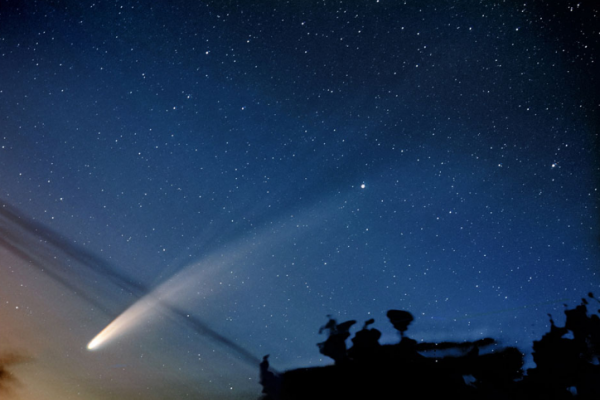Ohio SkyLites - October 2022

What’s Up? Constellations, Planets, and Astronomical Events Visible in October 2022
- Written and Compiled by Alyssa Whalen
Welcome to fall! Since the autumnal equinox is behind us, and the winter solstice is ahead of us, the nights will continue getting longer and longer. The time between sunrise and sunset decreases by approximately 2 minutes and 30 seconds each day, with an average day length of 11 hours; however, the length of the day varies between 11 hours and 45 minutes at the start of the month to 10 hours and 30 minutes by the end of the month.
October’s full moon will rise at sundown on October 9th. This month’s full moon is known as the Hunters Moon among Native Americans, as this time of year is when game is often hunted. This month’s new moon will occur on October 25th. The week prior and afterward will be the best conditions for observing (weather permitting) due to the dark skies. The moon phase cycle doesn't make much of a difference in the light-polluted city of Columbus. Still, if you find yourself in a dark sky site such as the John Glenn Astronomy Park in Hocking Hills, Ohio, the moonlight makes a huge difference in your visibility.
There are two meteor showers reaching their peak this month! The Draconids meteor shower runs annually from October 6th through October 10th, and it will reach its peak on October 7th this year with about 10 meteors per hour. This meteor shower peaks while the moon is in the first quarter, so the moonlight combined with the city lights will make viewing difficult; however, the brightest will still be visible if we’re lucky. The meteors will be most frequent in the constellation Draco, and therefore will be best viewed between sundown and midnight in the northern sky (Between the Big and Little Dippers).
The Orionids meteor shower runs annually from October 2nd to November 7th, and this year it peaks between October 21sth and 22nd. During the peak nights, it is expected we will see around 20 meteors per hour from the constellation Orion. In October, the constellation Orion does not rise until after midnight, so the best time to observe the meteor shower is between 1:30 am and sunrise in the eastern sky. There is a thin crescent moon during the meteor shower’s peak, so the moonlight should not have much of an effect on the visibility; however, it will be much more enjoyable if you can get away from the city lights.
In October, Jupiter and Saturn are still perfectly visible and bright along the ecliptic. The first to rise is Saturn, which will rise before sunset and set around 2:20 am. Jupiter will follow just before sunset around 6:00 pm and will set 6 hours later around midnight. Mars will also be clearly visible this month. It will rise on the eastern horizon later in the night around 10:00 pm and last until sunrise. Mercury will be at its greatest eastern elongation on October 8th, so it will be most visible in the morning (6:30 am), however, it is still very close to the sun. Conversely, Venus is currently too close to the sun to observe clearly. Uranus and Neptune are above the horizon during the night but are too small and faint to see without the aid of binoculars or a telescope. Uranus will rise close to 7:50 pm and Neptune will rise before sunset around 5:35 pm. Both Uranus and Neptune will stay up until sunrise.
Cassiopeia is a very simple constellation that is nearly overhead this time of year. It is easily found because of its iconic shape. It is commonly referenced as an “M” or “W” depending on the time of night as it moves around Polaris. This constellation can help point you towards the Andromeda Galaxy. The bottom of the “W” or top of “M” points the way our sister galaxy, Andromeda. To the naked eye, even in a dark sky, Andromeda looks like a cloud or smudge. A long-exposure is required to view the structure of the galaxy.
If you plan to stay up late into the night, the constellations Taurus and Orion will be on the rise now that fall is here. Taurus will be on the eastern horizon around 11 pm, and Orion will follow it around 2 am. Orion is most easily recognized by his belt; three bright stars in a diagonal line. Follow the slanted line away from the horizon to find Taurus. Just above Orion, you will also find the Gemini twins and their bright stars Castor and Pollux.
Sources
Information:
http://www.seasky.org/astronomy/astronomy-calendar-2022.html
https://www.timeanddate.com/astronomy/night/@5165418
Pictures:
Draco :https://theplanets.org/constellations/draco-constellation/
Cassiopea: https://earthsky.org/astronomy-essentials/2-ways-to-find-the-andromeda-galaxy/
Andromeda: https://esahubble.org/images/heic1112f/
Orion/Taurus/Gemini:https://stellarium-web.org/
